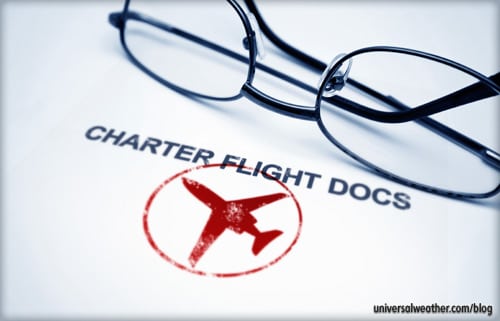Charter Flight Documents: Key Considerations for Charter Operators (Part 1)


This business aviation blog post is part of a series on charter flights.
Documentation requirements are often more challenging for charter (non-scheduled commercial) operations than for private non-revenue operations. Charter operators may not be fully familiar with unique charter-specific documentation requirements for certain countries, and this has the potential of causing operational delays. In some cases, operators may have documents that do not conform to the format requirements. Documentation needs are more rigorous today than just a few years ago, particularly for charter (also known as non-scheduled commercial) operators. Last minute document glitches can be a frustration and have the potential of hindering your trip.
1. Are there many differences in document requirements between charter and private non-revenue ops?
There are differences in documents required, quantities of documents, and requests for more specialized documents when operating as a charter. For example, Mexican insurance wording must be specific for charter as opposed to private non-revenue coverage. Another example is U.S. Customs bonds, which are needed to transport passengers on charter flights into and out of the U.S. These bonds take time to obtain and certain locations will not accept 3rd-party customs bonds.
2. What are some examples of these differences?
While most Civil Aviation Authorities (CAAs) require worldwide insurance along with airworthiness and registration certificates, additional documents are often required when operating as a charter flight. One of the biggest differences between charter and private non-revenue permits is the processing time required by the appropriate CAA. For example, if you are a first-time operator to Italy or haven’t operated there in the last two years, a minimum of 45 days’ notice is required before you can obtain a charter landing permit. In Japan, among other documents required, you must provide a copy of your charter agreement, listing at least one passenger and the terms of the charter flight, before a charter landing permit will be issued. Australia mandates that charter operators have an Australian security plan (also known as a TSP) in place, and this can require additional time to process if it hasn’t already been obtained.
In the U.K., charter landing permits require five working days with a minimum of 48 hours’ notice to obtain. In certain cases, your aircraft’s itinerary will be shared with U.K-based charter operators, who can potentially block your charter permit request, if the 4th, 5th or 7th Freedom Act is involved and if one of the U.K-based charter operators can offer a similar aircraft and route. This rule is mandated by the U.K. Department for Transport, and these U.K.-based charter operators will have 24 hours to respond after your itinerary has been shared.
In some countries, charter operators are required to submit a copy of their operations specifications or maintenance records prior to permit approval being granted.
3. Are many countries requiring country-specific documents in order to process a charter landing permit?
The short answer is yes. Some examples of countries requiring specific documents when operating charter flights are U.K., Germany, Spain, France, Italy, Australia, Japan, and some Atlantic islands. Switzerland recently initiated a charter landing permit requirement, whereas this wasn’t a requirement in the past.
4. What are standard documents necessary for charter permits?
While many CAAs differ on charter document requirements, a good place to start is to ensure you have clear copies (preferably .jpeg or .pdf copies) of worldwide insurance (with a war-risk clause) and European Union (EU) insurance, registration certificate, airworthiness certificate, U.S. Customs bond for clearance into the U.S., Part 298 Air Taxi Certificate (OST 4507) for U.S. operators, Air Operator’s Certificate (AOC) or Air Carrier Certificate (ACC), noise certificate and flight department’s operations specifications.
5. Is there a best way to obtain the latest information on specific document requirements for each country?
We recommend that you work with a 3rd-party provider well in advance, as documentation requirements change and you may at times not be aware of these changes until a short notice permit is required. Documentation must be assembled and forwarded all together at one time when requesting charter permits. Some countries, like Hong Kong and Taiwan, always require noise certificates, while other CAAs may ask for one, even though it’s not a standard requirement. In some cases, CAA may ask for documents that are not ‘officially’ required, or they may request additional documents for verification purposes. Documentation requirements can’t be avoided and not having the correct documentation readily available can, in many cases, cause delays. For example, Germany, Italy, Hong Kong, and Mexico all have specific insurance requirements separate from standard worldwide insurance, and it can take time to draft these documents. We consider it best practice to obtain updates on required documentation from time to time and to maintain copies on file with your 3rd-party provider.
Questions?
If you have any questions about this article, contact me at katherineperry@univ-wea.com.
We’ll continue this topic later in part 2 of this post.




